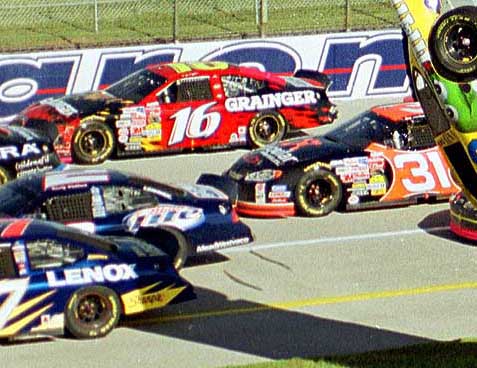NASCAR, I hear the words and images of guys from my high school come to mind. They have chewing tobacco in their mouths and carry a plastic bottle to spit it in. These guys raise beers and “holler” every time their favorite driver completes a lap on the track.
My stereotype of a NASCAR fan was shattered after interviewing Leigh Edmonds.
Edmonds has two degrees in Sports Management and interned at Darlington Raceways in South Carolina. She told me about Jim Hunter, a key figure in NASCAR history, who passed away this year.
In November, Ed Hinton, senior writer for ESPN.com, wrote a story about Hunter. Speaking of NASCAR’s glory days, Hunter takes a drag of his cigarette.
“Hinton, you and I are the last of the breed,” said Hunter.
Hunter worked for NASCAR from 1968-2010. He recently died at the age of 71.
I wanted to learn more about NASCAR’s history. Junior Johnson, a racecar driver, and one-time whiskey runner, emerged as another key figure in racing history.
Johnson, born and raised in North Wilkesboro, N.C, learned how to drive by running whiskey for his father, according to Esquire.com. Johnson, Sr. was one of the biggest moonshiners in their small town.
“Moonshiners put more time, energy, thought, and love into their cars than any racer ever will,” said Johnson in “Driving with the Devil,” by Neal Thompson. “Lose on the track, and you go home. Lose with a load of whiskey, and you go to jail.”
The original racers date back to prohibition times when moonshiners would race to outrun the cops. They eventually started racing each other to prove who was the fastest driver.
In the 1940’s, Big Bill France began organizing the smaller races and created rules to make the sport more official. In 1949, NASCAR held its first official race in Daytona, FL.
According to Edmonds, local guys drove these cars and this made the sport initially appealing. The fans and drivers shared the same small town roots.
“Their kids went to the same schools, and families to the same churches,” said Edmonds. “Fans felt like they knew their drivers. It was in every boy’s bones to want to drive fast and these drivers were their heroes.”
The drivers began to come from locations other than the South. The local fans now had to relate to a new group of racers.
Coming from the small town of Oak Ridge, N.C. I understand the bittersweet feeling that comes with small town growth. I find myself saying things like, “I remember when that was a tobacco field.”
I recently visited the local pool where I swam on the swim team. I expected to see at least one familiar face but I did not. While I enjoy diversity and traveling, I understand the veteran racers reminiscent feelings.
In the 1990’s, NASCAR started to become really popular and big names such as Jeff Gordon sprouted up. The drivers were getting younger and becoming, as my Grandmother might say, “Too big for their britches.”
Around this time, I can remember young Dale Earnhardt, Jr., on a poster for a popular men’s cologne. He looked clean cut in his racing gear.
“NASCAR realized that it wasn’t just old rednecks watching the sport,” said Edmonds.
In the late 1990’s, original racetracks in the south started to shut down. Southern racetracks moved to other regions of the U.S.
New TV contracts changed race times from after church to later in the afternoons. Fans had to make sure to check race times to keep up.
“I think there was too much change too fast,” said Edmonds. “With the death of Dale Earnhardt, Sr. and rising ticket prices, the sport started to move away from its blue collar southern roots.”
Edmonds still finds the sport appealing but simply notices how much the sport has changed.
Robbie Love shared his experience with the sport. Love does bear a southern accent but he also shattered my assumptions of a racing fan.
His father used to race on local tracks in the 1960’s. Dragged there weekly, Love rebelled by not liking the sport. A year ago, something made him re-think his stance on racing.
He watched a show on the History Channel called Madhouse. The show takes place at the Bowman Gray Stadium in Winston Salem, N.C.
The show features a set of drivers racing in the modified division, one of the roughest and competitive divisions of NASCAR. The viewers get the chance to see the driver’s race and see the drama off the track.
In the spring and summer, Bowman Gray Stadium has a short track race every Saturday night. Love started to attend races after seeing this show. They let you go into the race pit to meet the drivers after the race.
“I enjoy watching the crazy crowd,” said Love. “It also takes you away from reality just for a little while.”
NASCAR has its levels and divisions just like in other sports.
“The local stuff is like the minor leagues and they have a kind of cult following,” said Love. “It’s a different world and every kind of person is there.”
I looked at pictures of Love smiling beside a Madhouse racecar. I am reminded of what Edmonds said — it must be in every boy’s bones to drive fast — or at least watch others do it.
I have learned a lot about NASCAR. One source taught me about past appeal and the other about the current appeal, but at least I now understand the appeal.

